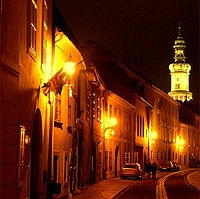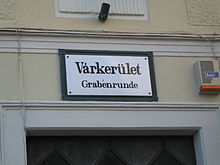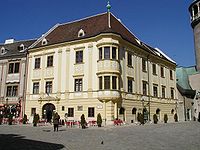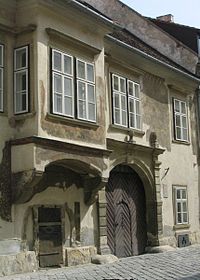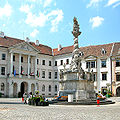- Sopron
-
This article is about the city. For the historical county in the Kingdom of Hungary named Sopron / Ödenburg, see Sopron (county).
Sopron Aerial photography of the City Hall and the Main square 
Flag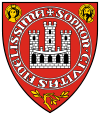
Coat of armsLocation of Sopron Coordinates: 47°41′06″N 16°34′59″E / 47.68489°N 16.58305°ECoordinates: 47°41′06″N 16°34′59″E / 47.68489°N 16.58305°E Country  Hungary
HungaryCounty Győr-Moson-Sopron Government – Mayor Tamás Fodor (Fidesz-KDNP) Area – Total 169.06 km2 (65.3 sq mi) Population (2011) – Total 60,755 – Density 342.45/km2 (886.9/sq mi) Time zone CET (UTC+1) – Summer (DST) CEST (UTC+2) Postal code 9400 Area code(s) 99 Sopron (Hungarian pronunciation: [ˈʃopron]; German: Ödenburg, Croatian: Šopron, Latin: Scarbantia) is a city in Hungary on the Austrian border, near the Lake Neusiedl/Lake Fertő.
Contents
History
Ancient times-13th century
When the area that is today Western Hungary was a province of the Roman Empire, a city called Scarbantia stood here. Its forum was located where the main square of Sopron can be found today.
During the Migration Period Scarbantia was believed to be deserted and by the time Hungarians arrived in the area, it was in ruins. In the 9th–11th centuries Hungarians strengthened the old Roman city walls and built a castle. The town received its Hungarian name at this time from a castle steward named Suprun. In 1153 it was mentioned as an important town.
In 1273 King Otakar II of Bohemia occupied the castle. Even though he took the children of Sopron's nobility with him as hostages, the city opened its gates when the armies of King Ladislaus IV of Hungary arrived. The king awarded Sopron by elevating it to the rank of free royal town.
16th-19th centuries
During the Ottoman occupation of Hungary the Ottoman Turks ravaged the city in 1529, but did not occupy it. Many people from the occupied areas fled to Sopron, and the city's importance grew.
In 1676 Sopron was destroyed by a fire. The modern-day city was born in the next few decades, when beautiful Baroque buildings were built in place of the old medieval ones. Sopron became seat of the comitatus Sopron.
20th century-present
Following the breakup of the Austro-Hungarian Empire, ethnic Germans inhabited parts of four western Hungarian counties: Pozsony (Pressburg in German; Bratislava in Czech/Slovak), Vas (Eisenburg), Sopron (Ödenburg) and Moson (Wieselburg). These counties were initially awarded to Austria in the Treaty of Saint Germain (1919). After local unrest, Sopron's status as part of Hungary (along with that of the surrounding eight villages) was decided by a controversial, local plebiscite held on December 14, 1921, with 65% voting for Hungary. Since then Sopron has been called Civitas Fidelissima ("The Most Loyal Town", Hungarian: A Leghűségesebb Város), and the anniversary of the plebiscite is a city holiday. However, the western parts of Vas, Sopron and Moson counties did join Austria and today forms the Austrian federal state of Burgenland, while Pressburg/Pozsony was awarded to Czechoslovakia.
Sopron suffered greatly during World War II, as the Nazis and their Hungarian allies transported to death camps and killed almost all Jewish citizens and some left-wing workers, and it was bombed several times. The Soviet Red Army captured the city on April 1, 1945. On August 19, 1989, it was the site of the Pan-European Picnic, a protest on the border between Austria and Hungary, which was used by over 600 citizens of East Germany to escape from the GDR to the West. As the first successful crossing of the border it helped pave the way for the mass flight of East German citizens that led to the fall of the Berlin Wall on November 9, 1989.
During the Socialist era the government tried to turn Sopron into an industrial city, but much of the medieval town center remains, allowing the city to remain an attractive site for tourists.
Today, Sopron's economy immensely benefits from the European Union. Having been a city close to nowhere, that is, to the Iron Curtain, Sopron now has re-established full trade relations to nearby Austria. Furthermore, after being suppressed during the Cold War, Sopron's German-speaking culture and heritage is now recognized again. As a consequence, many of the city's street-and traffic-signs are written in both Hungarian and German making it an officially bi-lingual city due to its proximity to the Austrian frontier. Visitors admire the large number of buildings in this city that reflect medieval architecture - rare in war-torn Hungary. Situated close to the Austrian border, Sopron receives many visitors from Vienna (70 km away), and from Bratislava, Slovakia (77 km away), as well as from the United States, Great Britain, The Netherlands, Japan, and Scandinavia, who visit to take advantage of the excellent low-cost dental services offered: Sopron boasts so many dental clinics—more than 300—that the city is known as the "dental capital of the world."[1][2]
Jewish history
Main article: Jewish history of SopronWine production
Sopron is a significant wine producing region, one of the few in Hungary to make both red and white wines. Grapes include Kékfrankos for red wine and Traminer (Gewürztraminer) for white wine. In climate it is similar to the neighbouring Burgenland wine region in Austria, and several winemakers make wine in both countries. Blue Frankish, Tramini, and Green Veltelini are well-known Sopron wines. Sopron's Blue Frankish and Pinot Noir wines are particularly prized.[3]
Demographics
Historical populations Year Pop. ±% 1870 23,102 — 1880 25,513 +10.4% 1890 29,788 +16.8% 1900 36,790 +23.5% 1910 38,114 +3.6% 1920 39,525 +3.7% 1930 40,906 +3.5% 1941 47,569 +16.3% 1949 36,506 −23.3% 1960 41,981 +15.0% 1970 47,952 +14.2% 1980 54,836 +14.4% 1990 55,083 +0.5% 2001 56,175 +2.0% 2011 60,755 +8.2% In 1910 Sopron had 33,932 inhabitants (51% German, 44.3% Hungarian, 4.7% other). Religions: 64.1% Roman Catholic, 27.8% Lutheran, 6.6% Jewish, 1.2% Calvinist, 0.3% other.[4] In 2001 the city had 56,125 inhabitants (92.8 % Hungarian, 3.5% German, 3.7% other).[5] Religions: 69% Roman Catholic, 7% Lutheran, 3% Calvinist, 8.1% Atheist, 11.9% no answer, 1% other.[6][7]
Architecture
The architecture of the old section of town reflects its long history; walls and foundations from the Roman Empire are still common, together with a wealth of Medieval, Renaissance, and Baroque structures, often artistically decorated, showing centuries of stability and prosperity.
There is an old synagogue and other remains from the town's former Jewish community, which was expelled in the 16th century.
On Daloshegy, there is a 165-metre tall FM-/TV-broadcasting tower, which looks has the nickname "Rakéta" (Hungarian for rocket).
Places of interest
- City centre
- Firewatch Tower
- Walls with Roman origin
- Széchenyi Square and Flag of Loyalty
- Kecske Church
- Esterházy Palace(baroque)
- Eggenberg House
- City Hall (eclectic, 1895)
- Storno House (renaissance)
- Fabricius House
- "Two Moors" House (18th century baroque)
- Chemist's Museum (15th–16th century. The house was pronounced the first national monument in Hungary by Louis II of Hungary in 1525.)
- Lábasház (16th–17th century)
- Gambrinus House (Old city hall)
- Taródi Castle (István Taródi built the castle by himself. He started the building operations in 1945, when he was 20.)
Amusement
- Cartoon Forum (From Tuesday 14 to Friday 17 September 2010)
- Spring Festival of Sopron (Soproni Tavaszi Fesztivál)
- Festal Weeks of Sopron (Soproni Ünnepi Hetek)
- VOLT festival
- Civitas Pinceszínház (Civitas Basement Theater)
- Liszt Ferenc Művelődési Központ (Franz Liszt Conference and Cultural Centre )
Photo gallery
-
Cézár Pince (traditional hungarian tavern)
-
Marian coloums.
-
St. Michael church
Sports
MFC Sopron was a football team based in Sopron.
Notable residents
See also Category: People from Burgenland.- Charles I of Austria, last king of Hungary
- Dániel Berzsenyi, poet
- Franz Liszt, composer
- Béla Bartók, composer
- Franz Lehár, composer
- Gyula Fényi, astronomer
- Franz von Suppé, composer
- László Rátz, mathematics teacher
- Margaret Mahler, psychoanalyst
- Georg Trakl, poet
- Rogerius of Apulia, medieval chronicler
- Mihály Tóth, football player
- Géza Ankerl, Professor of MIT (Massachusetts Institute of Technology), sociologist
- David-Zvi Pinkas, signatory of the Israeli declaration of independence
- Ludwig von Benedek, general
- Susie Babos, 2006 American collegiate singles tennis champion Susie Babos at Berkeley
- Kálmán Kánya, politician, diplomat, Foreign Minister
- Mátyás Rákosi, politician, communist dictator
- József Szájer, politician
- István Hiller, politician, Minister of Culture
- József Rokop, freedom fighter
- Vilmos Radasics, BMX rider
- Tímea Babos, tennis player
International relations
Main article: List of twin towns and sister cities in HungaryTwin towns — sister cities
Sopron is twinned with:
 Bad Wimpfen, Germany
Bad Wimpfen, Germany Bolzano, Italy
Bolzano, Italy Eisenstadt, Austria
Eisenstadt, Austria Wiener Neustadt, Austria
Wiener Neustadt, Austria Veliko Turnovo, Bulgaria
Veliko Turnovo, Bulgaria Eilat, Israel
Eilat, Israel
 Kempten im Allgäu, Germany
Kempten im Allgäu, Germany Mediaş, Romania
Mediaş, Romania Rorschach, Switzerland
Rorschach, Switzerland Seinäjoki, Finland
Seinäjoki, Finland Kazuno, Japan
Kazuno, Japan Sparta, Greece
Sparta, Greece
See also
References
- ^ "Sopron: Surmacz, Jon "Hungarian cap city" Tripso.com http://www.tripso.com/columns/sopron-hungarian-cap-city/ by Jon Surmacz
- ^ Mary Beth . "The inciDENTAL tourist" USA Today USAtoday.com http://www.usatoday.com/travel/news/2005-07-28-dental-tourism_x.htm
- ^ Wine Regions "Sopron" Winetime.com http://www.winetime.hu/index.php?option=com_content&view=article&id=52&Itemid=72&lang=en
- ^ 1910 census (English)
- ^ 2001 census - Nationalities (Hungarian)
- ^ 2001 census - Religions (Hungarian)
- ^ Historical population of Győr-Moson-Sopron (Hungarian Central Statistical Office) (Hungarian)
External links
- (English), (Hungarian), (German) Municipal website
- (English), (Hungarian) University of West Hungary (University of Sopron)
- (Hungarian) HelloSopron - Local Community Magazine
- (Hungarian) CyberPress - An informative magazine about Sopron's public life
- (Hungarian) IkvaHír - A city blog from Sopron
- (Hungarian) ImageTownsIndex - Virtual Tour of Sopron
- Sopron travel guide from Wikitravel
- Aerial photography: Sopron
- Kisfaludy Photo Galery
- Accommodation in Sopron
Counties of Hungary Counties Bács-Kiskun · Baranya · Békés · Borsod-Abaúj-Zemplén · Csongrád · Fejér · Győr-Moson-Sopron · Hajdú-Bihar · Heves · Jász-Nagykun-Szolnok · Komárom-Esztergom · Nógrád · Pest · Somogy · Szabolcs-Szatmár-Bereg · Tolna · Vas · Veszprém · Zala
Urban counties Békéscsaba · Budapest (capital) · Debrecen · Dunaújváros · Eger · Érd · Győr · Hódmezővásárhely · Kaposvár · Kecskemét · Miskolc · Nagykanizsa · Nyíregyháza · Pécs · Salgótarján · Sopron · Szeged · Székesfehérvár · Szekszárd · Szolnok · Szombathely · Tatabánya · Veszprém · ZalaegerszegCategories:- Sopron
- Populated places in Győr-Moson-Sopron county
- Siebengemeinden
- Wine regions of Hungary
- Hungary–Austria border crossings
Wikimedia Foundation. 2010.





